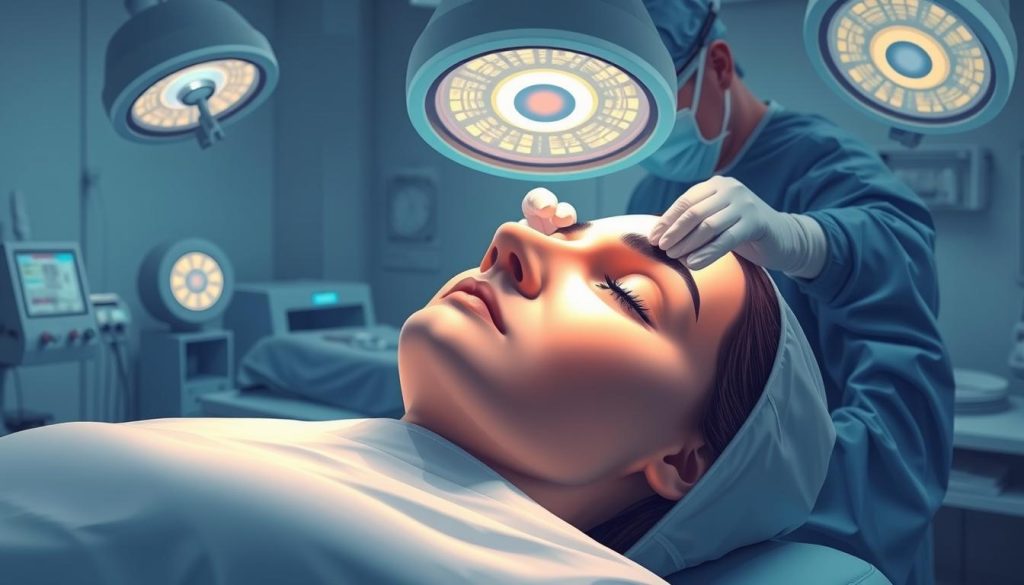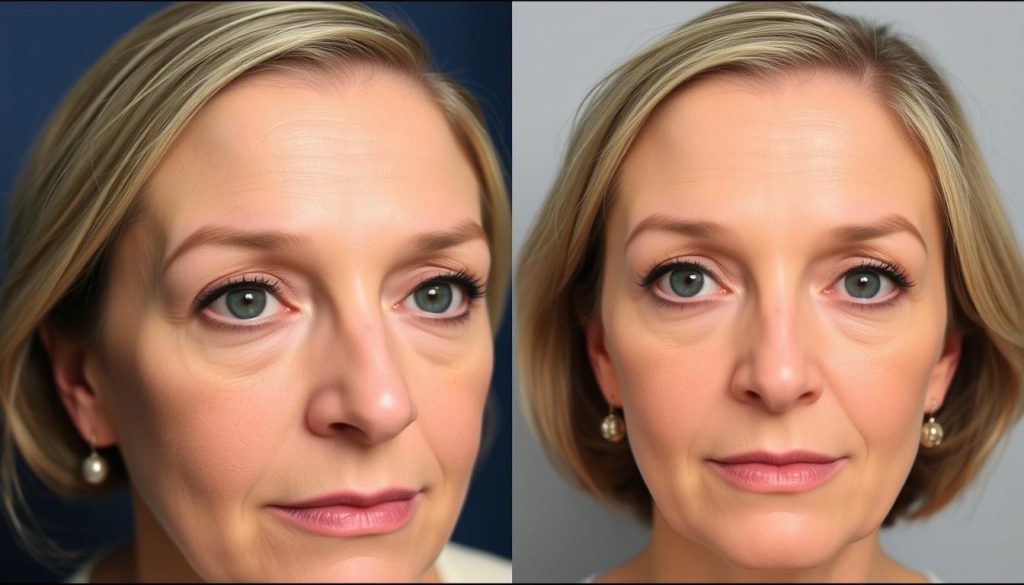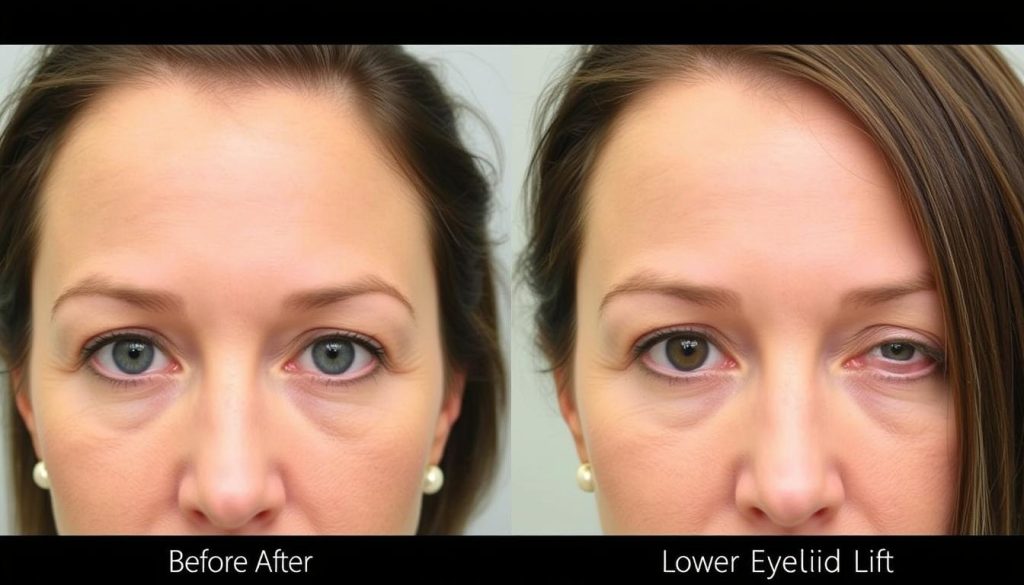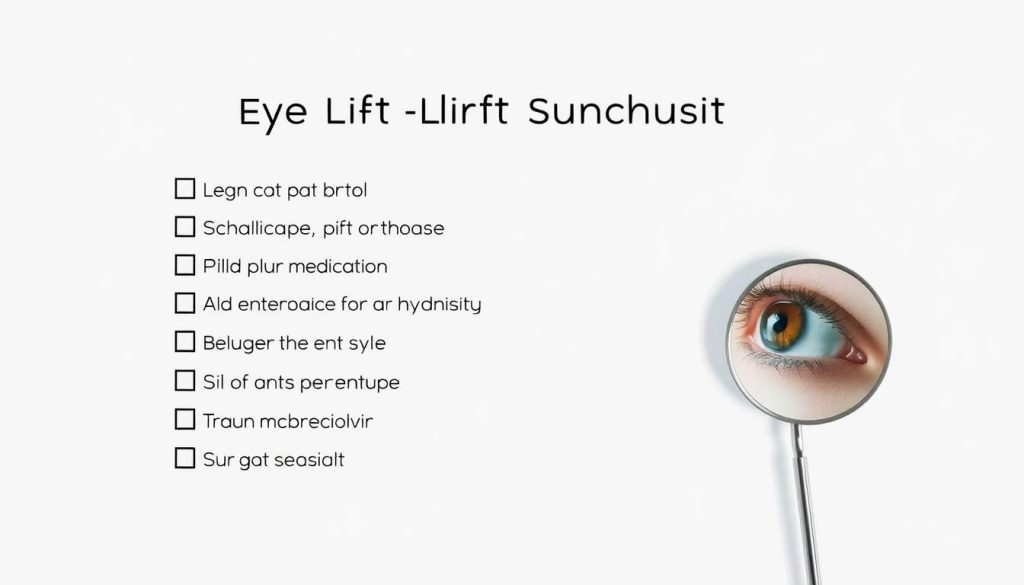Eye lift surgery, also known as blepharoplasty, is a popular facial rejuvenation procedure. It can dramatically enhance your appearance. This surgery targets the delicate area around the eyes, addressing signs of aging and fatigue.
Blepharoplasty offers a way to refresh your look without sacrificing your natural features. It removes excess skin and fat. This procedure can open up tired-looking eyes and restore a more youthful, alert appearance.
Whether you’re bothered by droopy eyelids or under-eye bags, eye lift surgery provides a solution. It can boost your confidence and revitalize your overall facial harmony. Let’s explore the transformative power of this procedure and what it can do for you.
Understanding Eye Lift Surgery: A Complete Guide
Eye lift surgery, also known as blepharoplasty, can change how you look and see. This guide covers the basics of eyelid surgery. It aims to help you understand your options for better eye health and looks.
What Is Blepharoplasty?
Blepharoplasty is a surgery that changes the eyelid’s shape. It fixes sagging skin, too much fat, and loose muscles. You can get it for the upper, lower, or both eyelids, based on what you need.
Types of Eyelid Surgery Procedures
There are different eyelid surgeries for different problems:
- Upper Blepharoplasty: Takes away extra skin and fat from the top eyelids
- Lower Blepharoplasty: Fixes under-eye bags and wrinkles
- Double Eyelid Surgery: Makes a crease on the top eyelid
- Ptosis Repair: Fixes droopy eyelids

Common Reasons for Seeking Eye Lift Surgery
People get blepharoplasty for many reasons:
| Aesthetic Concerns | Functional Issues |
|---|---|
| Puffy or baggy eyelids | Impaired peripheral vision |
| Tired or aged look | Hard to wear contact lenses |
| Uneven or asymmetrical eyelids | Eye strain from trying too hard |
If you want to fix droopy eyelids or look younger, knowing about eye lift surgery is key. Talk to a skilled surgeon to see if blepharoplasty is for you.
Benefits and Aesthetic Outcomes of Eyelid Surgery
Eye lift surgery does more than just make you look good. It can make you feel better about yourself too. Many people say they look and feel younger after getting this surgery.

This surgery helps reduce sagging skin around your eyes. It makes you look more awake and alert. Your eyes will seem bigger and more open, making you look friendlier.
Eye lift surgery also helps with vision. It can improve your peripheral vision by removing skin that blocks your view. This is great for older adults who have trouble seeing because of droopy eyelids.
“I never realized how much my droopy eyelids were affecting my vision until after my surgery. Now, I can see so much better, and I look years younger!”
The effects of eyelid surgery last a long time. Many people enjoy their new look for over a decade. To keep your eyes looking good, remember to take care of your skin and protect it from the sun.
Upper vs Lower Eyelid Surgery: Key Differences
Eyelid surgery, or blepharoplasty, can target either the upper or lower eyelids, or both. Each procedure addresses specific concerns and uses unique techniques to achieve optimal results.
Upper Eyelid Procedure Techniques
An upper eyelid lift removes excess skin and fat from the upper eyelid area. Surgeons make precise incisions along the natural crease of the eyelid to minimize visible scarring. This procedure can effectively treat droopy eyelids and restore a more youthful, alert appearance.
Lower Eyelid Treatment Methods
Lower eyelid surgery addresses under-eye bags and excess skin. Eye bag removal involves carefully extracting or repositioning fat deposits. Surgeons may use either a transcutaneous approach (incision below the lash line) or a transconjunctival approach (incision inside the lower eyelid) depending on the patient’s needs.

Combined Surgery Approaches
Many patients opt for both upper and lower eyelid surgery to achieve complete rejuvenation. This combined approach can provide balanced, harmonious results and often requires only one recovery period.
| Procedure | Target Area | Main Benefits |
|---|---|---|
| Upper Eyelid Lift | Upper eyelid | Removes excess skin, improves vision |
| Lower Eyelid Lift | Under-eye area | Reduces puffiness, smooths under-eye skin |
| Combined Approach | Both upper and lower eyelids | Comprehensive rejuvenation, single recovery period |
Choosing between upper eyelid lift, lower eyelid lift, or a combined approach depends on individual concerns and goals. Consulting with a board-certified plastic surgeon can help determine the most suitable option for achieving natural-looking, rejuvenated eyes.
Ideal Candidates for Blepharoplasty
Blepharoplasty, or eyelid surgery, can change lives. It’s best for adults with sagging skin around their eyes. Those with too much fat causing puffiness also benefit.
Age matters when thinking about eyelid surgery. Most are 35 or older. But, younger people might qualify if they have eye problems from family history. Being healthy is important for a good outcome and easy recovery.

- Droopy eyelid correction for better vision
- Removing extra skin that blocks your view
- Fixing uneven eyelids
Not everyone can get this surgery. Smokers, people with certain health issues, or those with high hopes that aren’t realistic might not fit. Talking to a certified surgeon can help figure out if it’s right for you.
“Blepharoplasty can enhance both appearance and functionality, improving vision issues caused by sagging eyelids.”
Knowing your goals and health is important before eyelid surgery. A skilled surgeon can help you decide if you’re a good fit for this life-changing procedure.
Preparing for Your Eye Lift Surgery
Getting ready for eye lift surgery needs careful planning. It’s a cosmetic procedure that requires specific steps for the best results. Let’s look at the main things to do before your surgery.
Medical Evaluation Requirements
You’ll need to do several medical checks before eye lift surgery. These tests help make sure you’re a good candidate for the surgery. They also help lower the risk of problems.
| Evaluation Type | Purpose | Frequency |
|---|---|---|
| Comprehensive Eye Exam | Assess eye health and vision | Within 3 months of surgery |
| General Health Check | Evaluate overall physical condition | Within 1 month of surgery |
| Blood Tests | Check for underlying health issues | 2-3 weeks before surgery |
Lifestyle Adjustments Before Surgery
To get your body ready for surgery, make these lifestyle changes:
- Quit smoking at least 4 weeks before the procedure
- Avoid alcohol for 1 week before
- Adjust medications as your surgeon tells you
- Eat a healthy diet with lots of vitamins A and C
Essential Pre-operative Instructions
Follow these important steps to make your surgery go smoothly:
- Arrange for someone to drive you on the day of surgery
- Don’t eat for 8 hours before surgery
- Wear loose, comfy clothes
- Remove contact lenses and eye makeup
- Get your home ready for recovery

By following these steps, you’ll be ready for your eye lift surgery. Always talk to your surgeon for advice that fits your needs and health history.
The Surgical Process and Recovery Timeline
Eye lift surgery, also known as blepharoplasty or eyelid surgery, is a transformative procedure. It requires careful planning and execution. The surgical process starts with anesthesia to ensure patient comfort during the operation.
During the procedure, the surgeon makes precise incisions along natural eyelid creases. Excess skin, muscle, and fat are removed or repositioned. This is done to achieve the desired aesthetic outcome. The incisions are then closed with fine sutures, minimizing visible scarring.
The recovery timeline for blepharoplasty varies from patient to patient. Immediately after surgery, patients may experience swelling and bruising around the eyes. Cold compresses and prescribed medications help manage discomfort during the initial healing period.
| Recovery Stage | Timeline | Expected Progress |
|---|---|---|
| Initial Recovery | 1-2 weeks | Reduced swelling, suture removal |
| Visible Improvement | 2-4 weeks | Return to normal activities |
| Final Results | 3-6 months | Complete healing, refined appearance |
Most patients can return to work within 7-10 days after eyelid surgery. Full recovery and final results typically become apparent within 3-6 months. Following post-operative instructions diligently ensures optimal healing and long-lasting results from your eye lift surgery.
Post-operative Care and Healing Guidelines
After eye lift surgery, it’s key to take good care of yourself. This guide will help you recover smoothly from your eyelid surgery.
Managing Swelling and Discomfort
Use cold compresses to lessen swelling after surgery. Take over-the-counter pain meds as your doctor suggests. Sleep with your head up to prevent fluid buildup around your eyes.
Activity Restrictions
For the first week, don’t do too much. Avoid heavy lifting, bending, and hard exercise. Keep your eyes safe from sun and wind. Wait for your doctor’s okay before wearing contact lenses.
Follow-up Appointments
Make sure to go to all your follow-up visits. These check-ups help your surgeon see how you’re healing and fix any issues quickly.
| Recovery Stage | Activities Allowed | Restrictions |
|---|---|---|
| Week 1 | Light walking, reading | No makeup, avoid sun exposure |
| Weeks 2-3 | Return to work, gentle exercise | No contact sports, limit screen time |
| Weeks 4-6 | Resume normal activities | Avoid direct sun on incisions |
Keep in mind, everyone heals differently after eyelid surgery. Always stick to your surgeon’s advice for the best results.
Potential Risks and Complications
Eye lift surgery, or blepharoplasty, can change your look. But, it’s key to know the possible risks. While rare, complications can happen. Knowing this helps you choose wisely for your health and looks.
Common side effects include temporary vision changes and dry eyes. These usually go away in weeks. Scarring is a worry, but skilled surgeons aim to keep it hidden. In rare cases, more serious problems might occur.
| Risk | Frequency | Management |
|---|---|---|
| Infection | Rare | Antibiotics |
| Bleeding | Uncommon | Compression |
| Asymmetry | Occasional | Revision surgery |
| Eyelid ptosis | Rare | Corrective procedure |
Choosing a board-certified surgeon lowers your risk of problems. Carefully follow all pre and post-operative advice. This ensures the best results from your eye lift surgery.
“Patient safety is our top priority. We thoroughly discuss all possible risks and take every precaution to minimize them.”
Remember, blepharoplasty is a surgery. Most people have good results, but it’s vital to consider the risks. Talk about any worries with your surgeon during your meeting.
Natural-Looking Results: What to Expect
Eye lift surgery is a popular choice for facial rejuvenation. It gives subtle yet powerful results. You’ll look refreshed and more youthful, but not dramatically changed.
Timeline for Final Results
The healing process after eye lift surgery happens in stages. You’ll see improvements in weeks, but full results take months.
| Time Frame | Expected Progress |
|---|---|
| 1-2 weeks | Swelling and bruising subside |
| 4-6 weeks | Incisions fade, eyes appear more open |
| 3-6 months | Final results become apparent |
Long-term Outcome Maintenance
To keep your eye lift surgery results looking great, follow these tips:
- Protect your eyes from sun damage with sunglasses and SPF
- Maintain a consistent skincare routine
- Stay hydrated and eat a balanced diet
- Avoid smoking and limit alcohol consumption
By sticking to these tips, you can enjoy your surgery’s benefits for years. Remember, eye lift surgery can reverse time, but it can’t stop aging completely.
Cost Considerations and Insurance Coverage
Eye lift surgery, also known as blepharoplasty, is a big step for your looks and confidence. The price changes based on the surgeon’s skill, where you live, and how complex the surgery is.
The cost of blepharoplasty is between $3,000 and $7,000. This includes the surgeon’s fee, anesthesia, and where the surgery is done. More detailed surgeries or both upper and lower eyelids might cost more.
Insurance for eye lift surgery depends on why you need it. Cosmetic surgeries are usually not covered. But, if it’s needed for vision, insurance might help pay for it.
Many plastic surgeons offer ways to pay for eye lift surgery. This includes payment plans or medical credit cards. Talk about money with your surgeon during your meeting.
“Investing in blepharoplasty can have a lasting impact on your appearance and self-esteem. While the cost may seem high, many patients find the results well worth the investment.”
Don’t forget to add extra costs like meds, care supplies, and lost work time to your budget. Thinking about these costs helps you decide if blepharoplasty is right for you.
Choosing a Qualified Surgeon for Your Procedure
Finding the right surgeon for your eye lift surgery is key to great results. A skilled surgeon can greatly improve your cosmetic eye procedure’s outcome.
Board Certification Requirements
When looking for a surgeon, always check for board certification. Look for credentials from groups like the American Board of Plastic Surgery or the American Board of Ophthalmology.
| Certification | Relevance to Eye Lift Surgery |
|---|---|
| American Board of Plastic Surgery | Expertise in facial plastic surgery, including eyelid procedures |
| American Board of Ophthalmology | Specialized knowledge of eye anatomy and function |
Questions to Ask During Consultation
Make a list of questions for your consultation. This will help you understand the surgeon’s experience and approach:
- How many eye lift surgeries have you performed?
- Can I see before and after photos of your previous patients?
- What technique do you recommend for my specific case?
- What are the possible risks and complications?
- How long is the recovery period?
A qualified surgeon will be open about their experience and answer your questions. Take your time to find the best surgeon for your eye lift surgery. This will ensure the best results for your cosmetic eye procedure.
Non-Surgical Alternatives to Eye Lift Surgery
Eye lift surgery isn’t the only way to refresh your look. Many people choose non-surgical options to tackle aging eyes. These methods can make a difference without the long recovery of surgery.
Botox injections are a favorite for smoothing out crow’s feet and lifting droopy brows. They relax muscles around the eyes, giving a younger look. Dermal fillers can fill in hollows under the eyes, making dark circles and bags less noticeable.
Laser treatments focus on fine lines and tighten skin around the eyes. They boost collagen, making skin look better over time. If you’re hesitant about surgery, these options offer good results with little risk.
| Treatment | Benefits | Duration |
|---|---|---|
| Botox | Smooths wrinkles, lifts brows | 3-4 months |
| Dermal Fillers | Reduces under-eye hollows | 6-12 months |
| Laser Treatments | Tightens skin, improves texture | Results build over time |
These alternatives can’t give the same big change as surgery, but they’re gentler. People often mix treatments for better results. Talking to a skilled doctor helps find the right non-surgical plan for you.
Long-Term Care and Maintenance After Surgery
After eye lift surgery, patients must focus on long-term care to keep their results looking good. Protecting the skin from the sun is key. Wear sunglasses and apply broad-spectrum sunscreen every day to prevent aging and protect the area.
Using a gentle skincare routine is important for those who have had eyelid surgery. Mild cleansers and moisturizers keep the skin hydrated and healthy. Doctors might suggest certain products to help with healing and keeping the results looking great. It’s important not to rub or pull at the eyelids to avoid irritation.
Lifestyle choices also affect the outcome of eye lift surgery. Drinking plenty of water, eating well, and getting enough sleep help the skin. Quitting smoking and drinking less alcohol also keeps the skin looking good.
As time goes on, natural aging will continue. Patients might want to try non-invasive treatments to keep their results looking fresh. This could include Botox or dermal fillers. Regular visits to the surgeon for advice can help keep the results looking great for years.
FAQ
Q: What is eye lift surgery?
A: Eye lift surgery, also known as blepharoplasty, removes extra skin, muscle, and fat from the eyelids. It aims to improve the eye area’s look and sometimes vision.
Q: Who is an ideal candidate for blepharoplasty?
A: Healthy adults with extra skin or fat around their eyes are good candidates. They should have droopy upper eyelids or under-eye bags. They must not smoke and have no serious eye problems.
Q: What’s the difference between upper and lower eyelid surgery?
A: Upper eyelid surgery removes extra skin and fat to fix drooping. Lower eyelid surgery gets rid of under-eye bags and puffiness. Some get both done at once.
Q: How long does recovery from eye lift surgery take?
A: Recovery time is about 10-14 days for most. Swelling and bruising go away in 2-3 weeks. It takes months to see the full results.
Q: Are the results of eye lift surgery permanent?
A: Eye lift surgery results last a long time but aging won’t stop. Lower eyelids last 5-7 years, and upper eyelids last 7-10 years. Lifestyle affects how long they last.
Q: What are the risks associated with blepharoplasty?
A: Risks include infection, dry eyes, and blurred vision. There’s also scarring and asymmetry. Rarely, vision loss can happen. Choosing a skilled surgeon and following instructions can reduce risks.
Q: Is eye lift surgery covered by insurance?
A: Insurance usually doesn’t cover it for looks. But, if it’s needed for vision, it might be covered. Check with your insurance.
Q: Are there non-surgical alternatives to eye lift surgery?
A: Yes, there are non-surgical options like injections, fillers, lasers, and creams. They offer some improvement but not as much as surgery.
Q: How do I choose a qualified surgeon for my eye lift procedure?
A: Choose a board-certified surgeon with eye lift experience. Look at their before-and-after photos. Make sure you’re comfortable with them during your consultation.
Q: How can I maintain the results of my eye lift surgery long-term?
A: Protect your eyes from the sun and live healthily. Use good skincare and don’t smoke. Regular check-ups with your surgeon help keep results looking good.

















